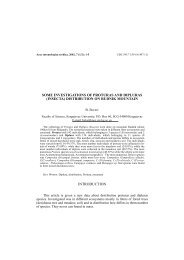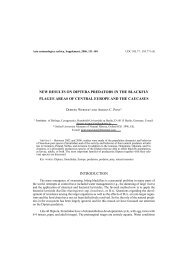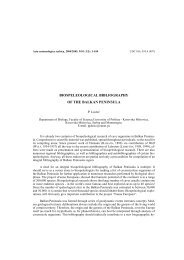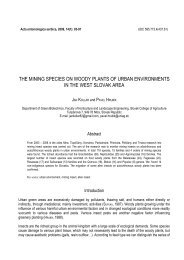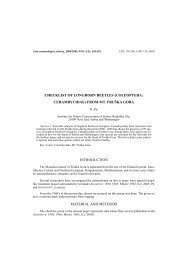Ćetković, A., Mokrousov, M., Plećaš, M., Bogusch, P., Antić, D ...
Ćetković, A., Mokrousov, M., Plećaš, M., Bogusch, P., Antić, D ...
Ćetković, A., Mokrousov, M., Plećaš, M., Bogusch, P., Antić, D ...
Create successful ePaper yourself
Turn your PDF publications into a flip-book with our unique Google optimized e-Paper software.
92 A. ĆETKOVIĆ et al.<br />
Croatia, Bulgaria), which shift the timing of the previously published “first appearance” dates in the area (for two years for<br />
N Serbia and C Greece), or otherwise modify the knowledge of its history of spread. Since the most recent evidence<br />
suggests the rapid eastward advancing of both introduced species towards their respective westernmost/northernmost<br />
native range limits in western to central Asia, we considered it important to briefly review the state of knowledge about<br />
their possible coexistence in that area. We also provided detailed maps of their allochtonous ranges in Europe (currently<br />
exceeding the longitudinal span of 4,000 km) and westernmost part of their native ranges in Asia. Finally, we very briefly<br />
commented on some ecological aspects of their existence within the allochtonous range (parasitism, sex ratio,<br />
phenology).<br />
KEY WORDS: Sceliphron deforme, Sceliphron curvatum, invasive Sphecidae, Europe, Balkans, Russia<br />
Introduction<br />
The guild of mud-daubing spider-hunting sphecid wasps of the subfamily Sceliphrinae is represented with two<br />
genera in Europe, Sceliphron Klug, 1801, and Chalybion Dahlbom, 1843, currently comprising 10 native and<br />
3 established exotic species (BITSCH, 2010; PULAWSKI, 2011). The European fauna of the genus Sceliphron<br />
includes 4 native species, three of them being relatively widespread in southern and to a lesser extent in<br />
central and/or eastern Europe: S. destillatorium (Illiger, 1807), S. madraspatanum (F., 1871), and S. spirifex<br />
(L., 1758); the fourth species, S. funestrum Kohl, 1918, is distributed only in some peripheral Aegean islands<br />
(and also further east, in Asiatic Turkey) (VAN DER VECHT & VAN BREUGEL, 1968; HENSEN, 1987; SCHMID-<br />
EGGER, 2005). During the second half of the 20 th century, two exotic species have become regular and widely<br />
represented members of the European fauna, the American S. caementarium (Drury, 1773) and Asian<br />
S. curvatum (Smith, 1870), as documented in numerous recent reports and reviews (PAGLIANO et al., 2000;<br />
GONSETH et al., 2001; ĆETKOVIĆ et al., 2004; BOGUSCH et al., 2005; SCHMID-EGGER, 2005; BITSCH & BARBIER,<br />
2006; BITSCH, 2010; PROKOFIEV & SKOMOROKHOV, 2010; RASPLUS, 2010; SHORENKO & KONOVALOV, 2010;<br />
BARBIER, 2011; etc.). The third alien species, S. deforme (Smith, 1856), also from Asia, was positively<br />
recorded only in the restricted area of European Russia (MOKROUSOV, 2000, 2003, 2008, 2010) and in<br />
southernmost Montenegro (ĆETKOVIĆ et al., 2004), but controversial evidence is reported about its<br />
occurrence/establishment in some other southern European countries (BITSCH & BARBIER, 2006; DAISIE,<br />
2008b; RASPLUS, 2010; RASPLUS et al., 2010; CABI, 2011b).<br />
The two Asian species are chromatically distinctive, hence easily recognised among other members of the<br />
genus found in Europe (SCHMID-EGGER, 2005; BITSCH & BARBIER, 2006). They are closely related and belong<br />
to the subgenus Hensenia Pagliano & Scaramozzino, 1990, which is predominantly distributed in Asia;<br />
S. funestrum is the only native member of this subgenus in Europe, while the rest of the European Sceliphron<br />
fauna belongs to the nominotypical subgenus, distributed worldwide. Described in the second half of the 19 th<br />
century, S. curvatum was treated as synonymous with S. deforme by several authors, the most influential<br />
being KOHL (1918) in his landmark generic monograph; its separate species status was restored by BOHART<br />
& MENKE (1976) and VAN DER VECHT (1984), but in part of the more recent literature, the failure to recognise<br />
the existence of two species has remained (e.g. KAZENAS, 2001). After HENSEN’s (1987) revision, their<br />
separate status and identification seem to be well established, but the practical problems may appear due to<br />
poor understanding of the full range of variability in both species, particularly where the ongoing spreading<br />
has brought (or soon will bring) about the overlap of their allochtonous ranges in diverse newly established<br />
areas of colonisation.<br />
In order to clarify the mentioned controversies about S. deforme, and in view of recent accumulation of new<br />
data, we are reviewing the state of knowledge of both introduced Asian species, with focus on the two<br />
principal areas: the Balkan Peninsula and European Russia. Also, for S. curvatum we are providing an



